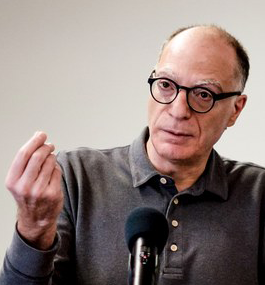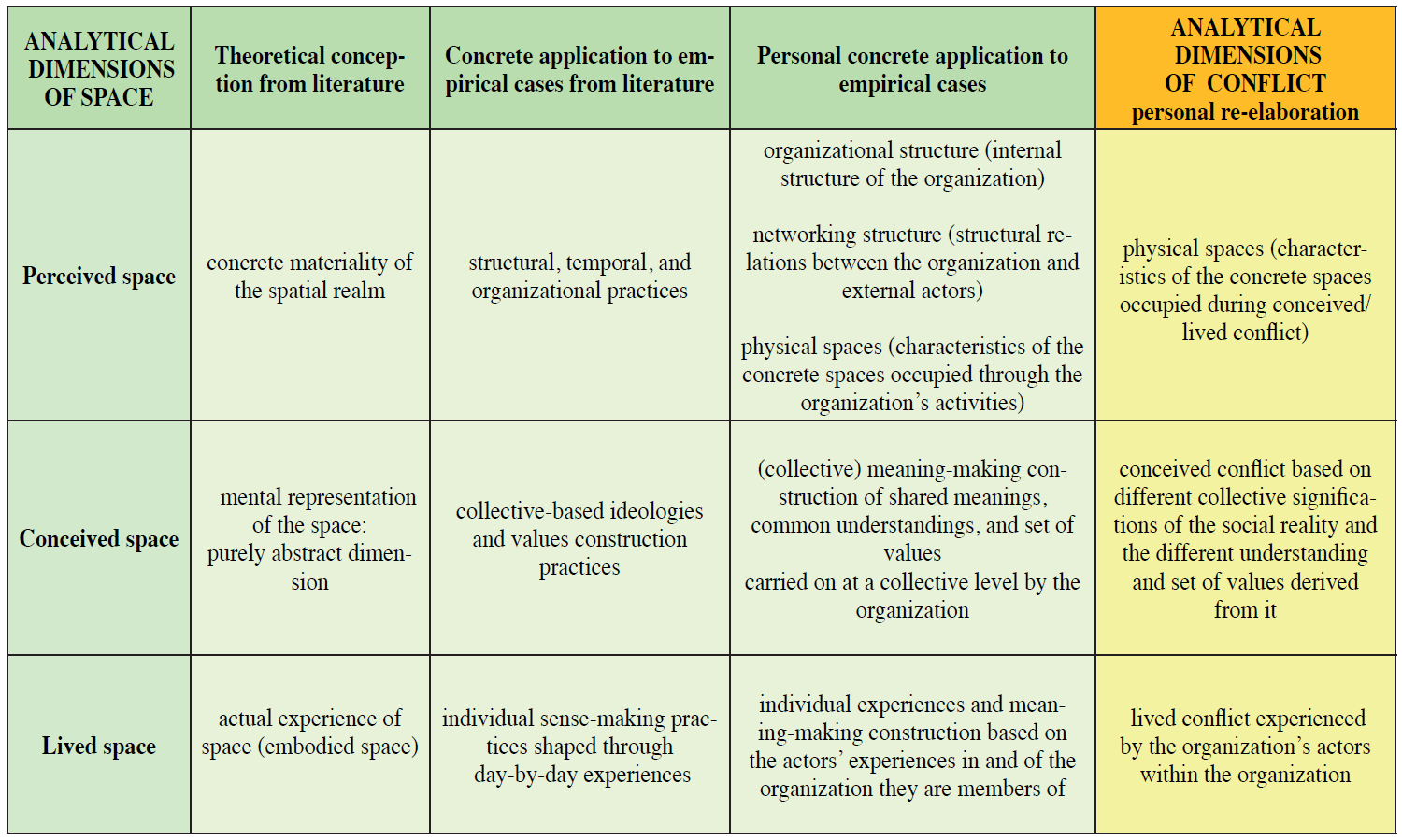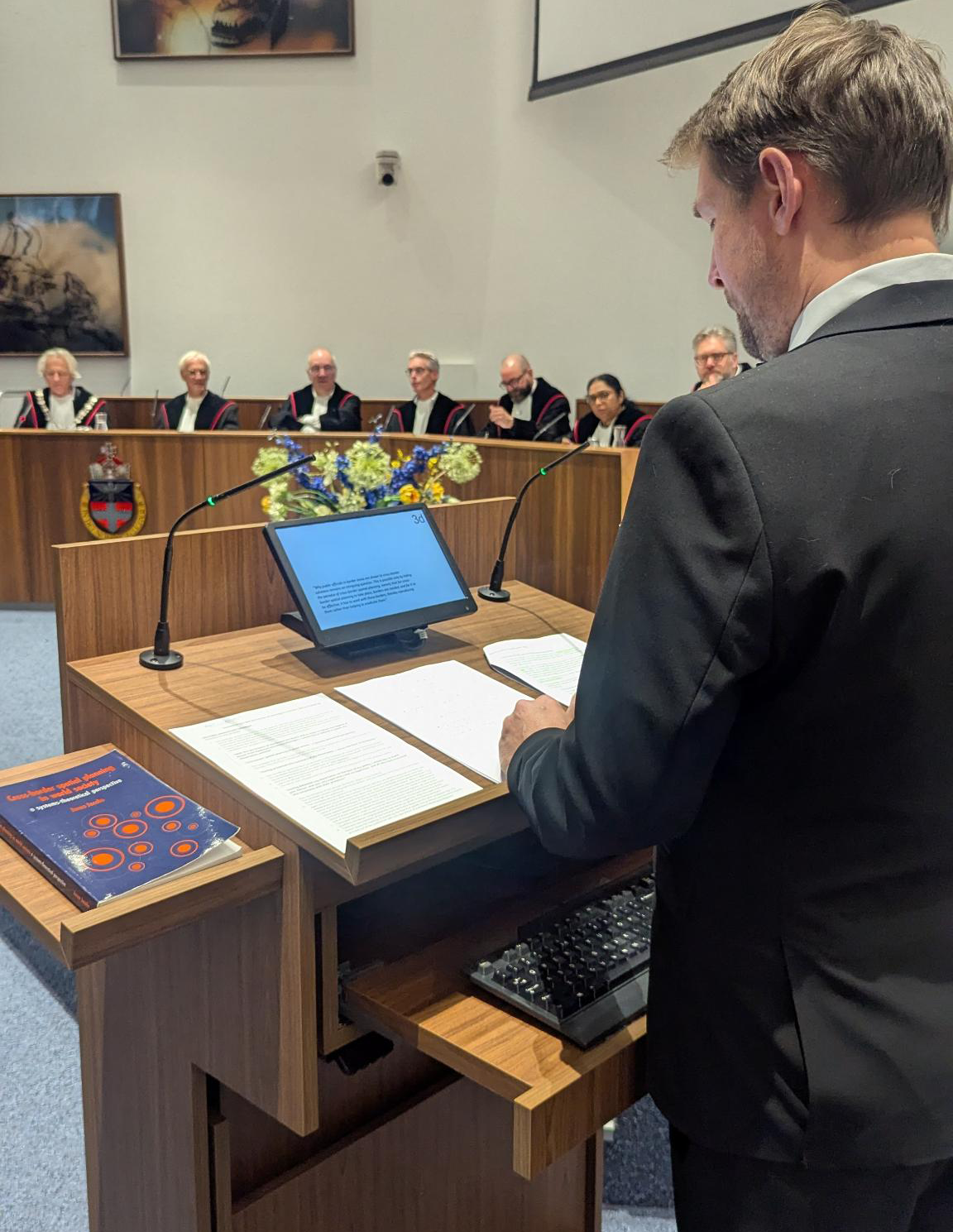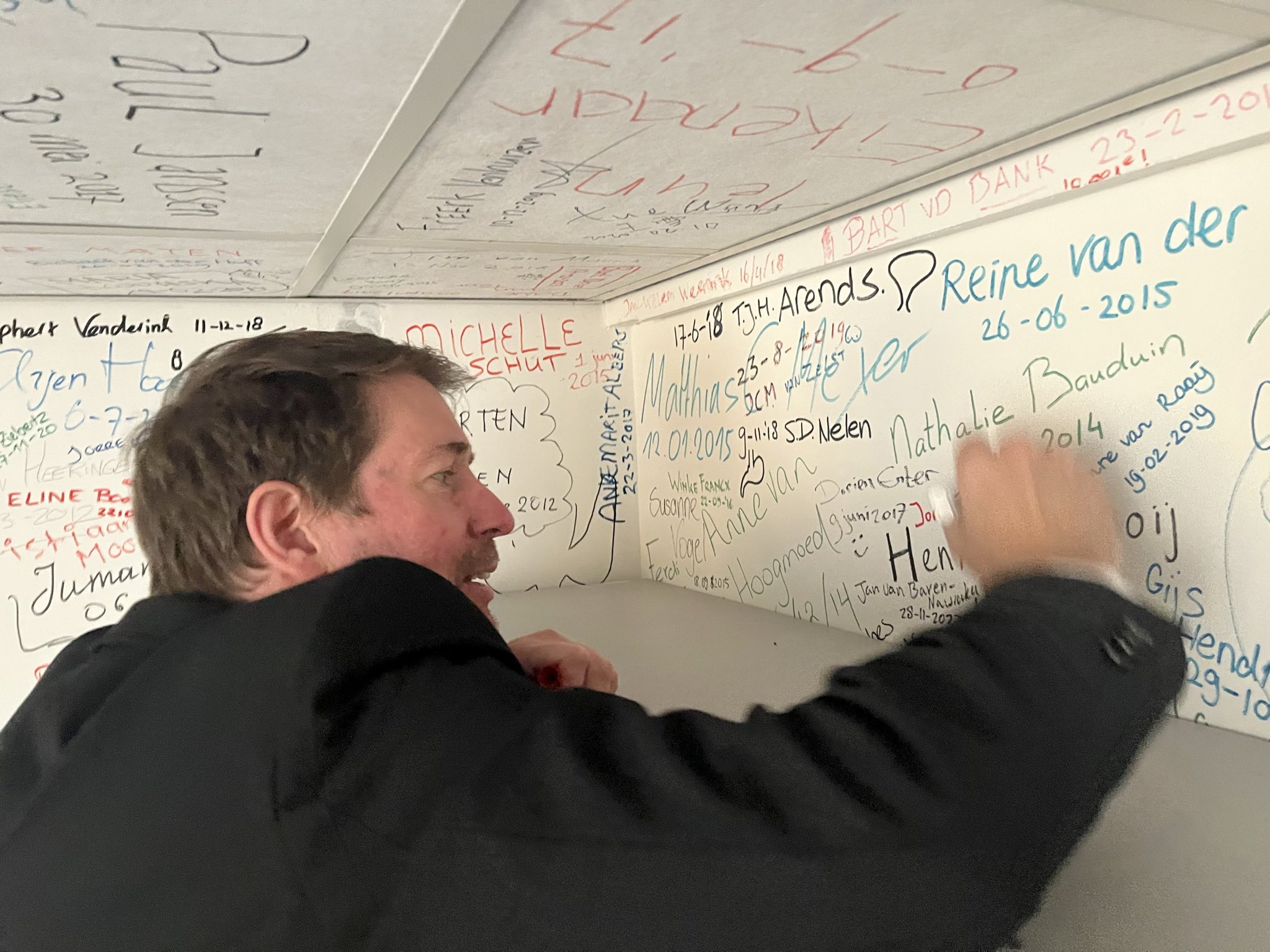On November 5th, 2024 I had the honour to serve as reviewer and opponent of the PhD thesis at the public defence of Dirk-Jan Laan at the Erasmus University in Rotterdam on “How to get where we are. A genealogy of the road” in the field of Philosophy,
 This multidisciplinary PhD Thesis is positioned at the interface between Philosophy, History, Geography and Spatial Planning and focusses on the road, as an emergent phenomenon developing into a directed and commonly shared route, material landscape, institutional arrangement and power geometry. It also combines different theoretical frameworks, while strongly emphasising a Foucauldian genealogical analysis. At the same time, it ogles with relational approaches, as well as with more philosophical conceptual (de)constructions This focus on the road as a key phenomenon instead of just focusing on the places or origin or destination fits very well to the very topical ‘Mobility Approach’ as also often applied in the field of Geography and Mobility Studies.
This multidisciplinary PhD Thesis is positioned at the interface between Philosophy, History, Geography and Spatial Planning and focusses on the road, as an emergent phenomenon developing into a directed and commonly shared route, material landscape, institutional arrangement and power geometry. It also combines different theoretical frameworks, while strongly emphasising a Foucauldian genealogical analysis. At the same time, it ogles with relational approaches, as well as with more philosophical conceptual (de)constructions This focus on the road as a key phenomenon instead of just focusing on the places or origin or destination fits very well to the very topical ‘Mobility Approach’ as also often applied in the field of Geography and Mobility Studies.
The PhD Defence attracted quite some attention from different media, e.g. on radio as well as in the ‘young talents’ section of the Newspaper ‘NRC-Handelsblad’. There Sjoerd de Jong described it as follows (my free translation into English):
‘Being on the road is not a necessary evil, but a way in which you learn how to discover and get to know the world’
Young learned Philosopher Dirk-Jan Laan likes to be on the road. His dissertation is therefore about ‘the road’, in a literal sense. ‘Ideally, we would teleport ourselves, then we would be rid of travelling,’ he says.

Photos by Roger Cremers
No, he doesn’t like sitting still very much. His PhD at Rotterdam’s Erasmus University has only just been completed and Dirk-Jan Laan is already hitting the road again. This time for a walking tour of several months through New Zealand. After his high school exams, he had already spent six months travelling around there. ‘I wasn’t able to finish that trip then due to injuries, but so we are going to do that now,’ He says.
Meanwhile, he has also become a tour guide and would also like to explore the world as a bartender, or cleaner. His CV underlines the itinerant nature of the young doctor (32): long treks through Wales, Iceland, and Japan. With a friend, he wrote a philosophical book about a hitchhiking trip to Hong Kong,
A Philosophy for Being on the Move (2022).
Why the Wanderlust? ‘It was in there from an early age. Once, when I was six, my father said we were going to sleep under the stars, I was ready with my rolled-up sleeping bag at five in the morning.’ The effect? ‘Walking gets you into a meditative rhythm. It’s no longer about the idea of going somewhere, but about being on the road. It’s a penetrating way to experience the world.’
Now he sat still for a long time, for his PhD dissertation on ‘The Road’ – not that one of Tao, but literally, on the roads of 17th-century England, on the cusp of the industrial revolution through to modern motorways. ‘I wanted to explore where our current roads come from,’ he says. Drawing on historical case studies and philosophers such as Foucault and Deleuze, Laan examines how ‘the road’ changed its character from the eighteenth century onwards. From a ‘right’ of passage managed by a community, it increasingly became a means for elites and governments to ‘discipline’ mobility and human bodies, with rules and regulations. At the same time, increased mobility produced a great subjective sense of freedom and new possibilities. ‘Like that, I could come here quickly now to talk about my dissertation. A hundred years ago, that would have taken two days.’
More traffic on worse roads
Laan chose England because social and technological developments came together nicely there: the containment of common land (and roads), the advent of railways and, in the 20th century, the construction of motorways. ‘In the 18th century, roads were already being used more and more intensively, making them worse to walk on. This led to irritation among business and political elites, because it took time, and in emerging capitalism, time was money. At that point, you can see a clash in England between that new efficiency thinking and an older, more communal and pastoral thinking about the road as a link between communities.’ From a ‘right’, the road became a ring-fenced piece of land, managed by elites and governments, with maintenance paid for by tolls.
That process of regulation had a parallel in the rapid proliferation of enclosures, the private subdivision of land hitherto worked in common. Common land gave way to private ownership and official control. ‘Many people fell out with that land division. So you got a working class without property, which was needed for the factories.’ That too led to a different handling of space and more regulation. Additional consequence: increased mobility. ‘Foucault also points that out. As a motorist, you are constricted by all kinds of regulations, figuratively and literally. But you experience it as freedom.’
Meanwhile, dealing with the modern road also grinds and creaks. Laan’s thesis ends up being an overview of the problems with contemporary mobility, traffic deaths and traffic jams problems with contemporary mobility, traffic deaths and traffic jams. On that, he lacks deeper reflection. ‘Very concrete goals are set within a certain framework. Fewer traffic jams. But you have to ask yourself whether our approach to the road as access to the world could be very different. Especially with a view to climate and sustainability.’ Laan participated in some of Extinction Rebellion’s highway blockades.
The Ministry of Transport is interested
So what does he suggest? ‘I was asked that during the PhD too. I don’t have any ready-made recipes; as a philosopher, I mainly want to question self-evidences. Open up new ways of thinking about our way of mobility and interaction with the world. We have come to see the road as a necessary evil: being on the road should be over as soon as possible. Ideally, we would like to teleport ourselves. But being on the road is also the way we discover the world. The places you visit, the space between them and the people you meet have their own value.’
Of course, he himself is curious ‘what practical impact my work can have’. The start is there: Rijkswaterstaat has already shown interest in his research. Meanwhile, Laan, who got his degree as an external PhD student, is picking up his work again as a programmer (he prefers to say, less one-dimensionally, ‘someone who programs’) at consultancy firm Quintens, which advises governments and companies on sustainability. But first the road beckons – to somewhere else. After academic work, Laan needs to get out of his ‘bubble’ again. ‘One of the theses accompanying my dissertation was that philosophers should focus more on the world and less on each other. This also applies to public philosophers, which often remains a bit of self-help philosophy anyway. It’s best to philosophise more firmly, people can handle that.’
| WHO IS DIRK-JAN LAAN? |
| – Year of birth |
| 1992 |
| – Year of birth |
| 1992 |
| – He lives |
| In Deventer. ‘It has a good train connection and we found affordable housing there. Neither my girlfriend nor I are tied to a place for work, she is American and works as a tour guide.’ |
| – Also likes |
| ‘Creative work, gardening, woodworking, drawing. Also on the road.’ |
| – Craziest hiking experience |
| ‘A railway line in Albania, which local residents also just used as a road, as used to be common elsewhere in Europe.’ |
 On Monday, Nov. 24, 2025, Veronica Pastorino successfully defended her PhD Thesis entitled: “Spatial Citizenship. Understanding the challenges and redefinitions of contemporary social cohesion through the analysis of the geographies of post-migrant contentious politics” (click on cover page to download full text). Through this defence, she did not just earn the PhD title from the Radboud University in Nijmegen, but also from the University of Bologna, as part of the Double Degree Programme between both Universities.
On Monday, Nov. 24, 2025, Veronica Pastorino successfully defended her PhD Thesis entitled: “Spatial Citizenship. Understanding the challenges and redefinitions of contemporary social cohesion through the analysis of the geographies of post-migrant contentious politics” (click on cover page to download full text). Through this defence, she did not just earn the PhD title from the Radboud University in Nijmegen, but also from the University of Bologna, as part of the Double Degree Programme between both Universities. Following the seminal work of the Citizenship scholar Engin Isin, Veronica suggests that this is much more than just a formality. It is not so much related to their judicial status, although,that is of course also part of it, but more related to becoming a full-fledged member of the host society and community, as well as to how others recognise them as such. It is much more a multiscalar ‘practice’ and a ‘process’. Citizenship emerges out of what political actors and ‘citizens’ do… This already makes it clear that it is not just an issue of nationality or of the nation-state, but also of the local and regional communities in which they are active. This brings in the dimension of space (or place). Identification with and belonging to a specific place can occur at different spatial scale levels. The way one might gain this kind of ‘citizenship’ can also vary from one place to another.
Following the seminal work of the Citizenship scholar Engin Isin, Veronica suggests that this is much more than just a formality. It is not so much related to their judicial status, although,that is of course also part of it, but more related to becoming a full-fledged member of the host society and community, as well as to how others recognise them as such. It is much more a multiscalar ‘practice’ and a ‘process’. Citizenship emerges out of what political actors and ‘citizens’ do… This already makes it clear that it is not just an issue of nationality or of the nation-state, but also of the local and regional communities in which they are active. This brings in the dimension of space (or place). Identification with and belonging to a specific place can occur at different spatial scale levels. The way one might gain this kind of ‘citizenship’ can also vary from one place to another. To conceptualise the complex spatiality of these processes, Veronica adopts and adapts the triad coined by Henri Lefebvre comprising Perceived Space (the more material and physical characteristics of space), Conceived Space (the conceptual and mental transposition of space) and Lived Space (the embodied and personally experienced aspects of space).
To conceptualise the complex spatiality of these processes, Veronica adopts and adapts the triad coined by Henri Lefebvre comprising Perceived Space (the more material and physical characteristics of space), Conceived Space (the conceptual and mental transposition of space) and Lived Space (the embodied and personally experienced aspects of space).
 Gaining citizenship is not an easy thing, and goes along with resistance and conflict and therefore can be described as a real ‘struggle’. This also demands critical reflection on how this actually takes place and might be improved. If it utterly looks as if it occurs smoothly and peacefully, there would be no reason to seek alternative ways of dealing with it, even though the underlying problems might still be there. Veronica, therefore, also concludes that some degree of irritation and conflict is actually needed to make critical reflection on these processes and ‘learning’ from errors effective.
Gaining citizenship is not an easy thing, and goes along with resistance and conflict and therefore can be described as a real ‘struggle’. This also demands critical reflection on how this actually takes place and might be improved. If it utterly looks as if it occurs smoothly and peacefully, there would be no reason to seek alternative ways of dealing with it, even though the underlying problems might still be there. Veronica, therefore, also concludes that some degree of irritation and conflict is actually needed to make critical reflection on these processes and ‘learning’ from errors effective. In this way, her research attempts to contribute to societal and political debates as well as to scientific debates in the fields of European Postmigration Studies, Social Movement Studies and Citizenship Studies by adding a critical spatial lens to it.
In this way, her research attempts to contribute to societal and political debates as well as to scientific debates in the fields of European Postmigration Studies, Social Movement Studies and Citizenship Studies by adding a critical spatial lens to it.

















































